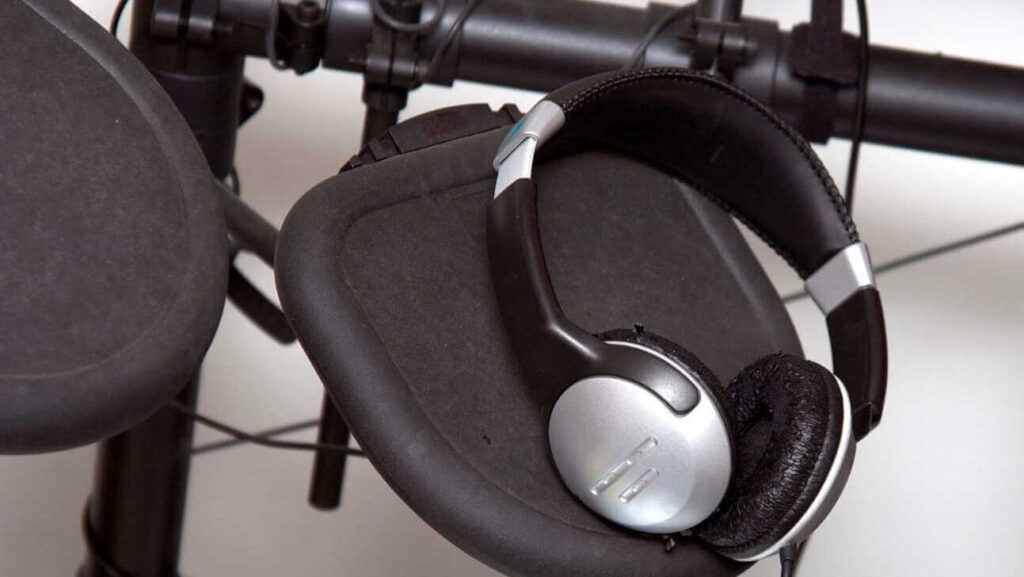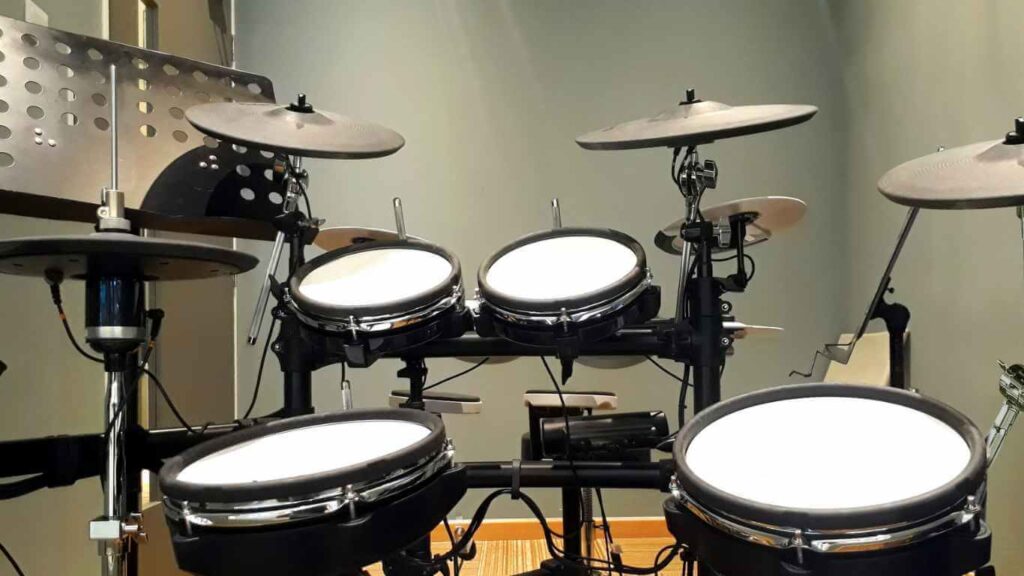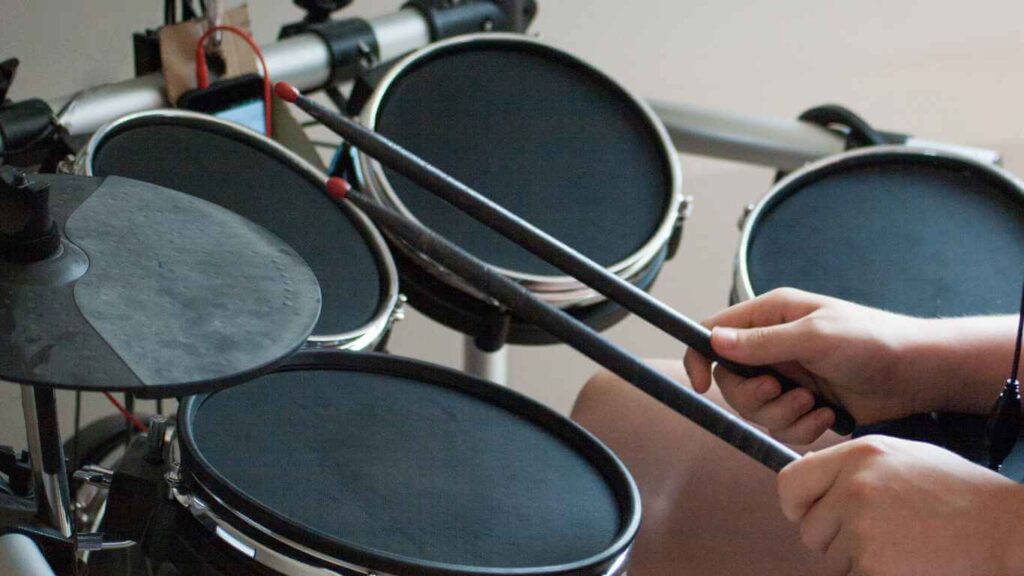Hey drum enthusiasts, Ron here! If you’ve ever faced the wrath of neighbors or the frustrated glances of family members while you’re pounding on your acoustic set, you know the struggle of finding the balance between passion and peace. Let’s dive into the world of electronic drums and discover how they can be the silent warriors of your musical journey.
The Quiet Revolution of Drumming
Gone are the days when the pulsating heartbeats of drumming were synonymous with noise complaints and frayed nerves. Welcome to the quiet revolution of drumming, a paradigm shift brought about by the advent of electronic drum kits. I’m Ron, and if you know anything about my love for drums, you’ll understand why this evolution in percussion technology strikes a chord with me.
In the sanctity of our homes, the thump and crash of acoustic drums can be overwhelming, making practice sessions a challenge. This is where electronic drums swoop in to save the day—and possibly your relationships. With the ability to contain the storm of sound to your headphones, these kits allow drummers to explore their passion without reserve, any time the inspiration strikes.
But it’s not just about keeping the peace. The innovation that electronic drums represent is a testament to how technology can transform an art form. It has democratized drumming, opening up new avenues for learning, creativity, and expression in the most unobtrusive way. The finesse involved in playing an electronic set can often be more demanding, honing a drummer’s skill set in a way that’s different from, yet complementary to, acoustic drumming.
This revolution isn’t a mere whisper in the world of percussion—it’s a resounding promise of balance, where the intensity of drumming coexists with the tranquility of our living spaces. As we delve deeper into this topic, we’ll see just how profound this silent uprising is and how it’s changing the drumming landscape, one quiet beat at a time.

The Virtue of Volume Control
Imagine having the power to dial down the thunderous roar of a drum kit to a gentle whisper, all without sacrificing the soul-stirring experience of playing. This is the remarkable advantage of volume control on electronic drums, a feature that I, as Ron the percussion aficionado, find utterly transformative.
The virtue of volume control extends beyond mere courtesy to neighbors. It allows for a mindful approach to practice, where you can play without causing auditory disruption to your environment. The volume knob becomes an ally, offering a range of dynamics that are not possible with traditional acoustic drums without dampening their natural sound. It means that practicing complicated passages at a lower volume can make it easier to concentrate on the nuances of technique and timing.
Moreover, the ability to control volume is not just about playing softer. It’s about exploring the full dynamic range of the instrument without reservation. You can experience the same emotional intensity at a reduced volume, ensuring that your playing remains expressive and dynamic. Volume control on electronic kits is not just a practical solution; it’s a new avenue of artistic expression, allowing drummers to explore their craft anytime, anywhere, without constraints. It’s a feature that has made drumming more inclusive and adaptable to the modern lifestyle, where space and noise levels are often limiting factors.

Headphone Heaven: Immersive Practice Sessions
Welcome to what I like to call ‘Headphone Heaven’, a realm where electronic drummers can immerse themselves in the richness of their instrument privately. For enthusiasts like myself, slipping on a pair of headphones while playing an electronic kit is akin to entering a new world, where every stroke and every beat is a clear, intimate experience.
Using headphones with electronic drums offers a focused practice session devoid of external distractions. It’s just you and your drums, up close and personal. This immersive practice allows drummers to hear the nuances in their playing, nuances that can be lost in the boom of louder environments. It’s about detail, the intimate clack of a stick hitting a rubber pad, or the subtleties within the rebound that might otherwise be missed.
But it’s not just about the notes and rhythms; it’s about the texture and tone of each sound. With a high-quality pair of headphones, the variety of tones within your module’s sound library becomes a treasure trove of sonic exploration. You can practice for hours, discovering new sounds and settings, something that would be impractical, if not impossible, at high volumes. In ‘Headphone Heaven’, you find yourself getting lost in the music, which can be profoundly beneficial for honing your skills and maintaining your passion for drumming.
Building Precision: The Electronic Feedback Loop
Diving into the concept of precision in drumming, electronic drums offer a unique feedback loop that is quite enlightening. As someone who’s spent countless hours behind both acoustic and electronic sets, I can attest to the remarkable way electronic drums can sharpen your skills. With each strike eliciting a programmed sound, these kits can mirror your playing with unyielding accuracy, revealing both strengths and areas for improvement.
This immediate feedback is essential for building precision. On an electronic kit, there’s nowhere for sloppy hits to hide; a missed accent or a double-trigger is instantly noticeable. This makes electronic drums a powerful tool for developing a cleaner, more precise playing style. It’s about transforming every session into a lesson in accuracy, encouraging drummers to play with intention and attention to detail.
Moreover, many electronic drum modules come equipped with built-in metronomes and training functions. These features further enhance the feedback loop, allowing drummers to practice to a constant beat and measure their timing against a precise standard. When you play an offbeat note, you hear it instantly, and this real-time feedback compels you to adjust on the fly. Over time, this process builds a drummer’s internal metronome, making precision second nature. Through electronic drumming, you engage in a constant cycle of performing, listening, and correcting, which is the essence of the feedback loop that hones a drummer’s precision.

Tactile Response: Maintaining Acoustic Feel
In the realm of electronic drumming, one critical concern I often hear from my percussionist peers is the feel. After all, the tactile experience of striking a drumhead is deeply ingrained in a drummer’s muscle memory. Here’s where the marvel of modern technology steps in: advanced electronic drum kits have been meticulously engineered to emulate the rebound and feel of their acoustic counterparts.
When we talk about tactile response, we’re discussing how closely the pads of an electronic drum mimic the physical sensation of playing an acoustic set. The goal is for drummers to transition seamlessly between the two without skipping a beat—literally. The surface you strike influences not just the sound produced but also how your playing technique develops. That’s why many electronic kits now feature mesh heads or textured silicone pads, which respond to the drummer’s touch in a way that’s reminiscent of traditional skins.
The subtleties in the tactile response also allow for nuanced playing. Advanced e-drum systems can detect different dynamics, from the softest ghost note to the most thunderous roll. This sensitivity is crucial for drummers who rely on the acoustic feel to express their musicality. By offering adjustable settings, electronic drums let you fine-tune the responsiveness to match your playing style. Whether you’re practicing late at night with the volume turned down or recording in a studio, the quality of the tactile response ensures that the physical connection to your instrument remains uncompromised.
Space-Saving Solutions for Smaller Quarters
One of the unsung heroes of the electronic drumming world is its compactness. For drummers living in tight apartments or sharing their space with others, the traditional drum kit can pose a significant challenge. It’s not just about the volume; the physical footprint of an acoustic set can dominate a room. This is where the space-saving solutions of electronic drum kits truly shine.
Electronic drums offer a sleek, minimalist setup that can fit into the corner of a room or be packed away when not in use. Unlike acoustic drums that spread out with their sprawling stands and wide-ranging components, electronic kits are often designed with a more vertical orientation. The pads and cymbals are mounted on racks that can be adjusted to fit into oddly shaped spaces or to accommodate the ergonomics of the player, without compromising on the full experience of a drum set.
Moreover, for those of us who need to make every square inch count, the ability to break down and store an electronic drum kit is a game-changer. In a matter of minutes, the entire set can be collapsed and tucked away into a closet or under a bed. This aspect not only makes electronic drums ideal for small living quarters but also for drummers who are constantly on the move. Whether you’re in a dorm room, a studio apartment, or a shared house, electronic drums ensure that your passion for rhythm takes up no more space than necessary.

Playing with Precision: Less Noise, More Nuance
Silent practice on electronic drums does more than just keep the peace with neighbors and roommates—it’s also a boon for honing precision in your playing. When the volume is turned down, or you’re plugged into headphones, you can focus intensely on the nuances of your technique without the distraction of high decibel levels. This environment is ideal for working on the subtleties that differentiate good drummers from great ones.
Without the acoustic boom of a bass drum or the crash of cymbals filling the room, you can concentrate on the details of stick control, dynamics, and timing. The electronic pads provide a uniform surface that can sometimes reveal inconsistencies in your strikes that acoustic drums might mask with their overtones and resonance. By training in such a precise context, you develop a sensitivity to your touch and the subtlety of ghost notes, flams, and intricate fills.
This focus on nuance extends to the use of electronic drum modules which often include metronomes and play-along tracks. Such tools are invaluable for working on timing and for practicing complex rhythmic patterns at a lower volume. Additionally, the immediate feedback from electronic drums, often with visual indicators on modules, allows drummers to adjust their playing in real-time, promoting a more disciplined and refined technique. With these advantages, electronic drums not only facilitate silent practice but also sculpt a drummer’s approach toward a more nuanced and controlled performance.
The Long-Term Gains: Protecting Your Hearing
The topic of hearing protection is one that’s all too often neglected in the drumming community. Yet, when it comes to electronic drums and silent practice, we inadvertently stumble upon one of the greatest long-term health benefits for any musician: the preservation of our hearing. By practicing at lower volumes, we’re not only being considerate to those around us but also to our future selves.
Drumming, especially on acoustic sets, can produce sound levels that reach the threshold of pain and can lead to hearing damage over time. This is where electronic drums become an invaluable asset. With volume control at our fingertips, we can significantly reduce the risk of tinnitus and long-term hearing loss, conditions that are sadly quite common among professional musicians. We no longer have to sacrifice our passion for drumming on the altar of our health.
Moreover, by utilizing headphones, we can control the sound environment completely, reducing it to a level that’s comfortable and safe for extended practice sessions. This not only protects our ears but also enables us to play for longer periods without fatigue, which is crucial for both professional drummers and dedicated enthusiasts. Practicing with electronic drums doesn’t just offer immediate satisfaction; it’s an investment in the longevity of our musical journey and the preservation of our most critical asset as musicians—our hearing.
The Sound of Silence
In the realm of drumming, silence can be just as powerful as a thunderous roll. Electronic drums offer a pathway to practice that respects the soundscape of our environment while providing a platform for growth and refinement of your craft. They’re an invaluable tool for any drummer looking to practice in peace and with precision.




